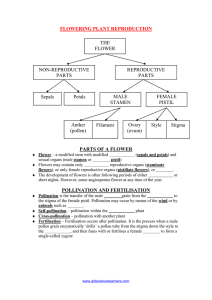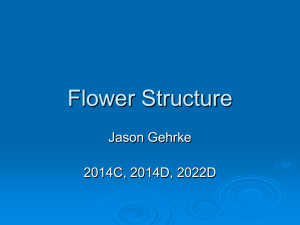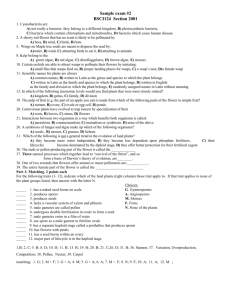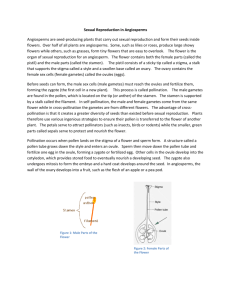Reproduction Asexual vs. Sexual
advertisement
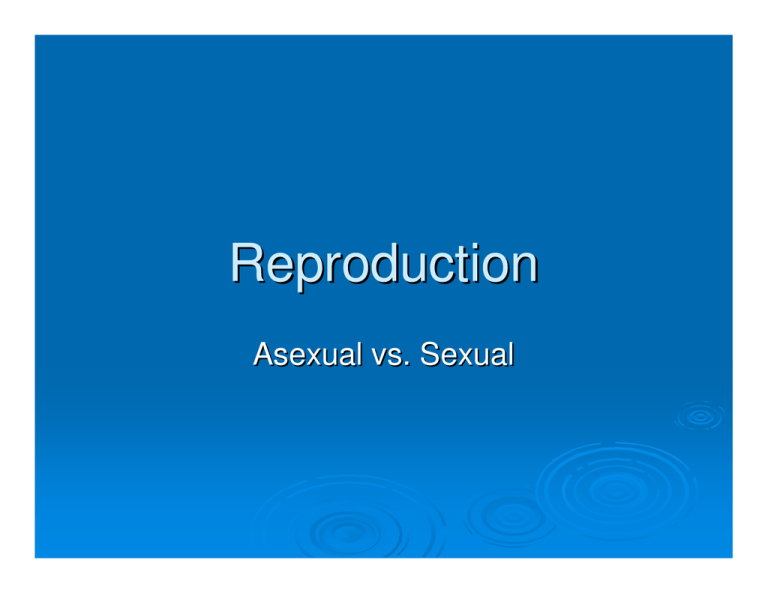
Reproduction Asexual vs. Sexual Asexual Reproduction Involves one parent or parent part Involves mitosis, not meiosis Offspring’s DNA is identical to parent Advantage? Parent and offspring are both adapted Disadvantage? No variation Binary Fission (Mitosis) Amoeba Planaria Regeneration Hydra Hydra Budding Hydra Sexual Reproduction Daphnia – “water flea” Plant Asexual Reproduction Bulbs – underground stems that grow into new plants by mitosis Cuttings – pieces of plant stems, roots, leaves rooted in soil Why asexual? Why identical? Runners – stems “creep” along the ground and grow a new identical plant by mitosis Sexual Reproduction – Plants Seed Producing Plants Cone - bearing Pine Cones Female Pine Cone Flowers Flower Parts Flower Parts Receptacle – top of stem upon which the flower sits Sepal – usually green; leaf-like; protects the flower bud prior to opening Collectively called the Calyx Petal - usually brightly colored Function? Protect reproductive parts; attract insects Collectively called the Corolla Male Flower Parts Male part of the flower – Stamen Consists of: a. Anther – sac that produces pollen b. Filament – stalk that supports anther Female Flower Parts Female part of the flower – pistil (carpel) Consists of: a. Stigma – sticky; at the top; attracts insects; collects pollen b. Style – stalk that supports the stigma c. Ovary – swollen structure at the base; contains ovules (eggs); Fertilized eggs become seeds Flower Vocabulary Complete = has sepals, petals, stamen and pistil (Most flowers) Incomplete = lacks sepals, petals or both Usually “not pretty” Ex: some trees, grasses Perfect = has both pistil and stamen (Most flowers) Imperfect = has only pistil (pistillate) or has only stamen (staminate) Ex: corn, oak trees Sometimes are even on separate plants! Ex: pussy willow, gingko trees Most flowers are perfect and complete with several stamen and one pistil Why? Scientific name: Ginkgo biloba Common names: Ginkgo, Maidenhair Tree: Home Previo us Next Info List Pussy Willow Bush Pollination Process by which pollen is transferred from anther to stigma Self - occurs within the same flower Cross – occurs between two different flowers on two different plants of the same species What about two different flowers on the same plant? Still Self for is the same organism/same DNA Corn Pollination Wind Vs. Insect Pollination Only about 10% of flowering plants are wind pollinated Which ones? What attracts insects? Wind Pollination Ovule Fertilization Pollen lands on stigma Grows a pollen tube down the stigma to reach the ovary Inside the tube are two nuclei from the pollen grain (“sperm nuclei”) Meanwhile the ovule has already divided into multiple cells One sperm nucleus fuses with some ovule cells to form “food” Why do seeds need food? Second sperm nucleus fuses with an ovule cell to form an embryo Pollen grain Ovule Fertilization Actually a “double fertilization” 1. Food usually called endosperm Some seeds contain a lot of it Often is starch Ex: corn 2. Second fertilization is the embryo Fruit Development and Seed Dispersal Eventually flower petals, sepals, the pistil and stamens usually wither and fall off If ovules have been fertilized, they begin to grow and the ovary swells Called – biological Fruit Roles: protect and disperse the seeds (scatter far from parent) Biological Fruits Seed Dispersal Bean Seed Embryo Cotyledon = name of basic seed part Contains the embryo and endosperm food Embryo Parts a. epicotyl (plumule) = set of baby leaves b. hypocotyl = baby stem c. radical = baby root Called Dicot – has 2 cotyledons Corn Seed Embryo Monocotyledon (Monocot) Contains only one cotyledon Usually lots of endosperm Monocots Vs. Dicots Flowering plants can be classified into two basic groups Monocots Vs. Dicots Dicots – two seed parts (cotyledons), branched veins in leaves, flower parts in multiples of 4 or 5 Monocots – one seed part (cotyledon), straight veins in leaves, flower parts in multiples of 3 Seed Development

